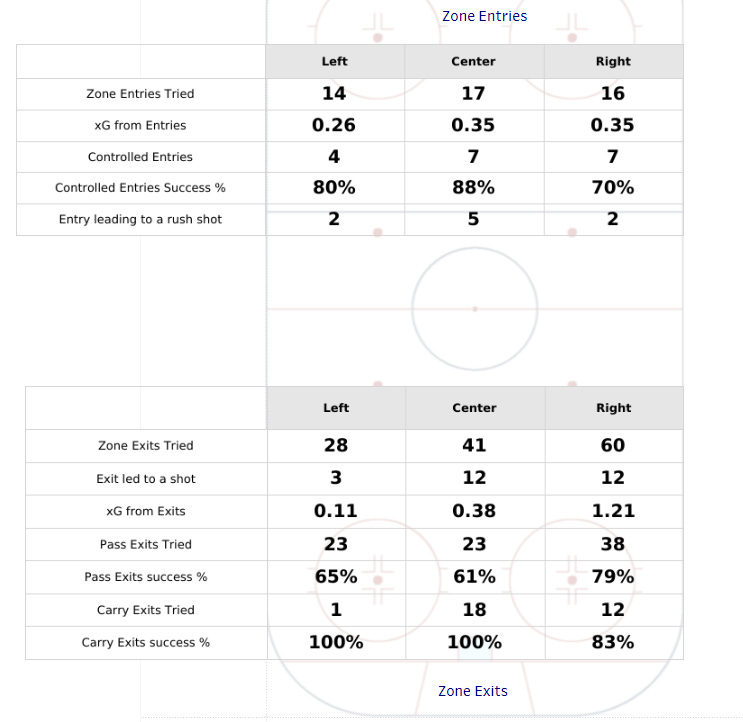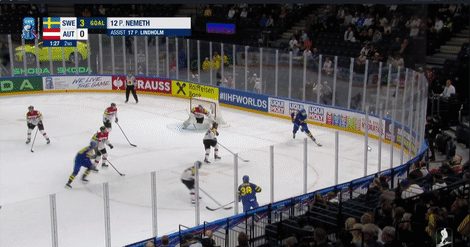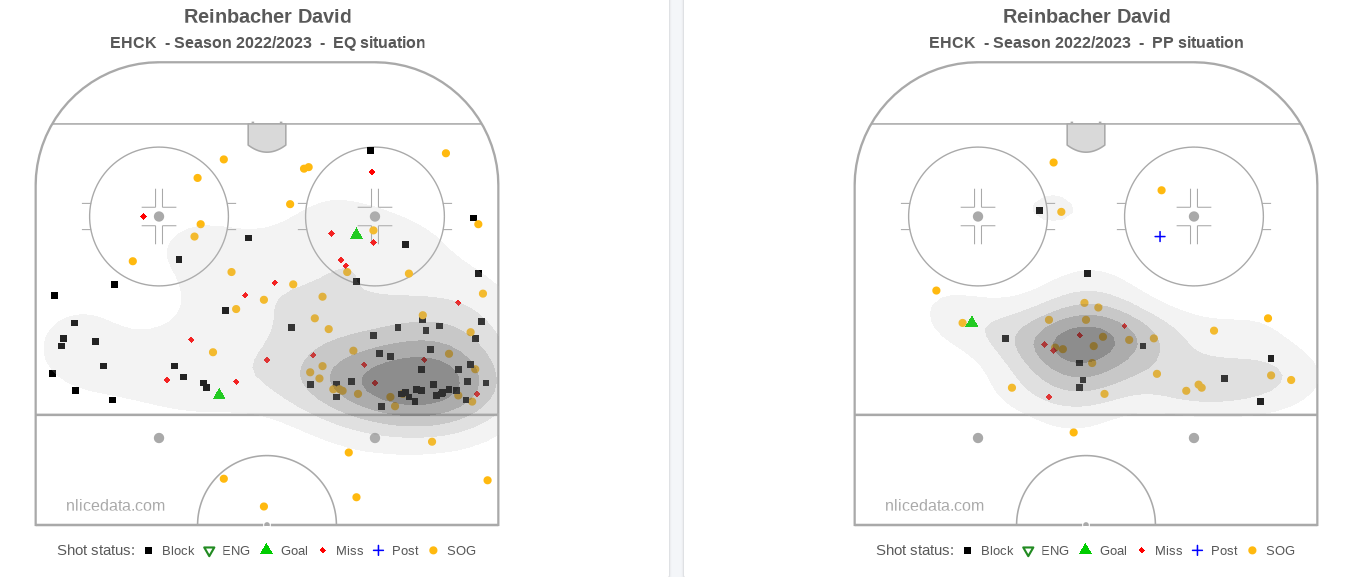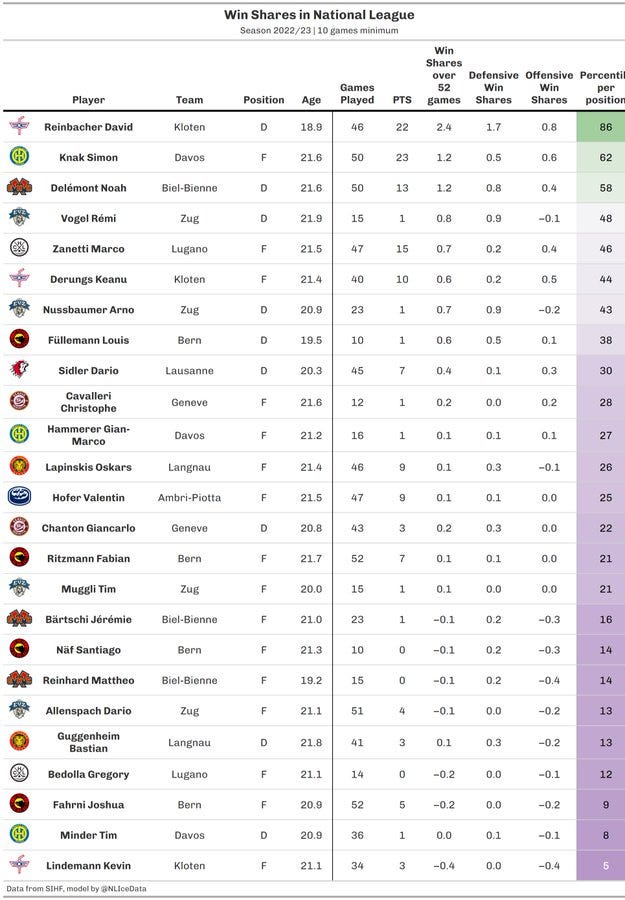You know, we, NLIceData are a company focused on the Swiss National League.
I, Thibaud, live in Montreal.
The Canadiens just drafted David Reinbacher with the 5th overall pick in the 2023 NHL Entry Draft.
This is a perfect world.
At NLIceData, we manually track a large number of National League games for our subscribers and the teams we are consulting for. Which means we got an extensive look at Reinbacher throughout the season, tracking 22 games and 359 5v5 minutes of him.
Here is what we learnt.
Our Draft model had him as the best defenseman available, by far, ranking 6th overall behind the highly skilled group of forwards.
Here’s what we were writing yesterday about him:
Austrian sensation David Reinbacher is the first defenseman (in the model), and the only one befor a while. Having played pro but on the second Swiss level division last year, he was a force as an 18 years old in the Swiss National League, where prospects simply almost never play, and certainly do not get first roles. Reinbacher enjoyed playing on a “no-ambition” team in Kloten, getting the highest time on ice among defensemen there at 5v5. He beat Roman Josi performance on points but comes behind Josi on Win Shares, which average out with a 82% probability of making the NHL. Having tracked him about 25 times with NLIceData this season, we are certainly happy to see this kid and the National League recognized at that level.
To get deeper, we also have a Prospects model, which looks at every player from 16 to 22 and project their potential career till they reach 30 years old. On this one, Reinbacher was simply the second best player in the Draft behind Bedard, with a 52% chance of being an “Elite” (top 10%) player in the league on average during the next decade.
His development
How did he get there? By taking advantage of every opportunities that presented to him. The Austrian moved to next door Switzerland very early and moved up the ranks inside the Kloten organization. The Zürich suburban town of Kloten has a long hockey story but had been relegated to the second level, the “Swiss league”, not long ago. At 17 years old, Reinbacher was scoring a point per game with the U20 and was able to begin playing with the pros on a limited role but with already positive 5v5 impact numbers on the ice, especially defensively. And he got to participate in Kloten winning the Swiss League title to move up to the National League.
We can see that his progression in the model has been linear but the true explosion happened this season of course. Taking a major step up in his development, not only he followed Kloten up in the National League but quickly established himself as their top defenseman there, alongside a Swedish import player managing the top power-play role on his side.
Reinbacher played close to 19 minutes a night in Kloten, 16 of those at 5v5, being the most used defenseman at even-strength. Playing on the other top4 pair, away from the offensive Swedish defenseman, Reinbacher was tasked to shutdown the best opposition night after night, and still ended up with a positive impact at 5v5 on expected goals, both offensively and defensively, while Kloten was ending 12th out of 14 teams on Expected Goals % and with the 13th defense for Expected Goals allowed by 60 minutes.
Not an easy environment.
His pair with veteran Steve Kellenberger was actually the only one in Kloten to end above 50% of goals at 5v5 beside star forwards Miro Aaltonen.
5v5 play
Like we said, Kloten had not the best roster in the league this season but they still managed to get into the play-in round, ending 10th in the standings, by playing with the tools they had at their disposal. One thing was to accept they were gonna suffer a lot at 5v5, but kept it safe in the neutral zone, and focusing on boxing out the opponents in their defensive zone. Something Reinbacher was pretty good at already.
His puck battle and retrieval numbers might be low (39th percentile among defensemen), but at 18 years old it was more interesting to see what he was doing with the pucks he was recovering. In the defensive zone he was turning recoveries into controlled exits at a solid rate, and manufacturing shots in the offensive zone after a puck win at an even higher rate.
This is a key trait about him. Reinbacher has drawn some negative feelings among fans for his lack of flashiness, but he is as close as being mature as an 18 years old has ever been.
His game is all about making the smart decision, in all three zones. The first mistakes he made early in the season were rapidly corrected. He tightened his gap against rushes and zone entries in general, chose when to be physical in his zone, and did especially well with the puck on his stick.
He ranked at the 81st percentile among defensemen for his ability to make successful, controlled zone exits.
As part of the Kloten system, once the defense could get their hands on the puck, it was all about starting rushes and counters. His first pass was essential, with a high 79% success rate on his natural right side of the ice.
And if those transitions did not lead to more shots, that’s a team effect more than anything. Same things for zone entries. He was not involved that much because defensemen were often far from the action by the time Kloten’s rushes were reaching the offensive blue line.
But that is something we see him capable of doing once he is part of a more offensive structure. When he tried zone entries with Kloten, his success rate was very decent and we could spot a tendency for attacking the center ice. The unfortunate play that got him injured at the World Championships was actually a good example of that.
Number 64 white here, sees his team recovering the puck, offers himself as a solution behind the net, then moves on to become the third forward in the developing play, gets the puck and accelerates down the middle with linear crossovers. Before getting greedy and clipped by NHL defensemen. That happens. But the intention was perfect.
Reinbacher scored 3 goals this season, for 19 assists. At 5v5 he kept to his right side for sure but also tried to get to the homeplate, with a good rate of putting the puck on net there (yellow dots). On the power-play, he also was efficient for getting pucks on target from his point role.
This is not meant to be a clip heavy article, but this last sequence caught some attentions at the time, and serves as a good conclusion here, showcasing Reinbacher’s IQ and potential once the ice opens up.
Playing 4v4 near the end of a game this Winter, David Reinbacher (#64 blue) just overskates former NHLer Alex Formenton, switches back to center ice and shoots. He then follows up on the recovery, wins a puck against Formenton and former NHLer Tim Heed before serving his teammate on a platter.
He kept moving. Body protection is good, stick handling is accurate, he faces the play during the cycle, knows where his teammates are. Being in the crucial minutes of a game against a direct opponent for the playoffs and facing borderline NHLers. Not bad at all.
A season for the ages
Reinbacher ended the season at the 86th percentile among defensemen for Win Shares, on his draft year, which is beyond impressive. The National League is NOT a development league, simply because there is not that many good enough local talent to play there (the best Swiss prospects are playing in Canada mostly) and the number of import players is limited to 6 per night, so no foreign prospects - Reinbacher has a Swiss licence. And because you cannot toy around with the risk of being relegated, which would be a massive financial blow to your organization. This year, only three players under 22 years old ranked above the 50th percentile at their position and Reinbacher was obviously the youngest and best of them all.
Now, the National League has not produced many future NHLers, and certainly not top5 picks. The one comparison that immediately comes to mind is Roman Josi. While they are not the same style of players, they were both good/great prospects on their Draft year. Reinbacher outscored Josi by a good margin while playing more minutes. And on Win Shares, he comes just above Josi’s already impressive 83rd percentile.
But it might be more fair to look at closer comparable, for whom we also have more complete data than Josi’s 2008 numbers. European recent studs include David Jiricek and Moritz Seider, who both played in their top local league on their Draft year. And Reinbacher performed better than both of them.
Where does Reinbacher fit in the Montreal system?
From what we heard, Reinbacher wishes to remain one more year in Kloten, in order to complete his business school degree. He could have 100% played in the AHL in our view but that’s more than okay. The National League is now probably the fourth best league in the world and he will continue to develop fine there before making the jump.
Since it began clear he was getting traction for the Draft, we labeled Reinbacher as a future number 2 defenseman in a contending team. Why number 2? Simply because he is not a Cale Makar or an Adam Fox. He is the cornerstone that will be playing a lot of minutes, against the toughest opposition, and end up winning the 5v5 possession battle. Number 2 means he will free Lane Hutson to do what he wants, playing beside him, or taking care of business on the other pair of your top4. He is also not your power-play quarterback, but can handle the second wave for sure.
He is a type of player Montreal did not have yet, and immediately becomes the most all-rounded defenseman in the system.
Going back to our Prospects model, he slides in right behind Cole Caufield as the second best player under 22 in the organization right now. His average projection per season till he reaches 30 years old is on par with Lane Hutson’s. If those two can be Elite (top10%) defensemen for 50% of their next decade, that’s gold.
Comparing him to every defensemen under 22, he also directly enters the top10, in pretty good company.
Slow down your horses
Okay. This is all pretty and well. But is it?
He is a kid that beneficiated from a unique playing opportunity in a very good league.
Yes but he absolutely made the most of it!
He was asked simple plays, in a non-dominant team.
And he did well, leveraged his team when he was on the ice, learnt how to make the smart choice in a tough environment.
He is not a future star, come on….
We think he is a modern case of a rounded defenseman, so mature that he was worth a top10 pick in any given year. Like Nemec and Jiricek were last year. Or Seider before them, who caught some fire for Detroit selecting him so high.
Yes, there are more flashy offensive defensemen than him, but what guarantees do they bring? And, yes Montreal has clearly drafted for need as well, with him being right-handed, but despite how unnatural it may sound to our cynical mind, we keep finding reasons justifying this pick.
Anyhow, we are very excited to track him next year again and follow his development.


















Great article, thanks for the in-depth write-up
Great article. Got a question tho, can you compare all habs d-men youngster to see who rank where ?! Still wonder where Reinbacher Barron Mailloux Engstrom can slot with Hutson Guhle Xhekaj Harris Struble. I'm kinda lost and want to understand how stats can shed some light. THX!